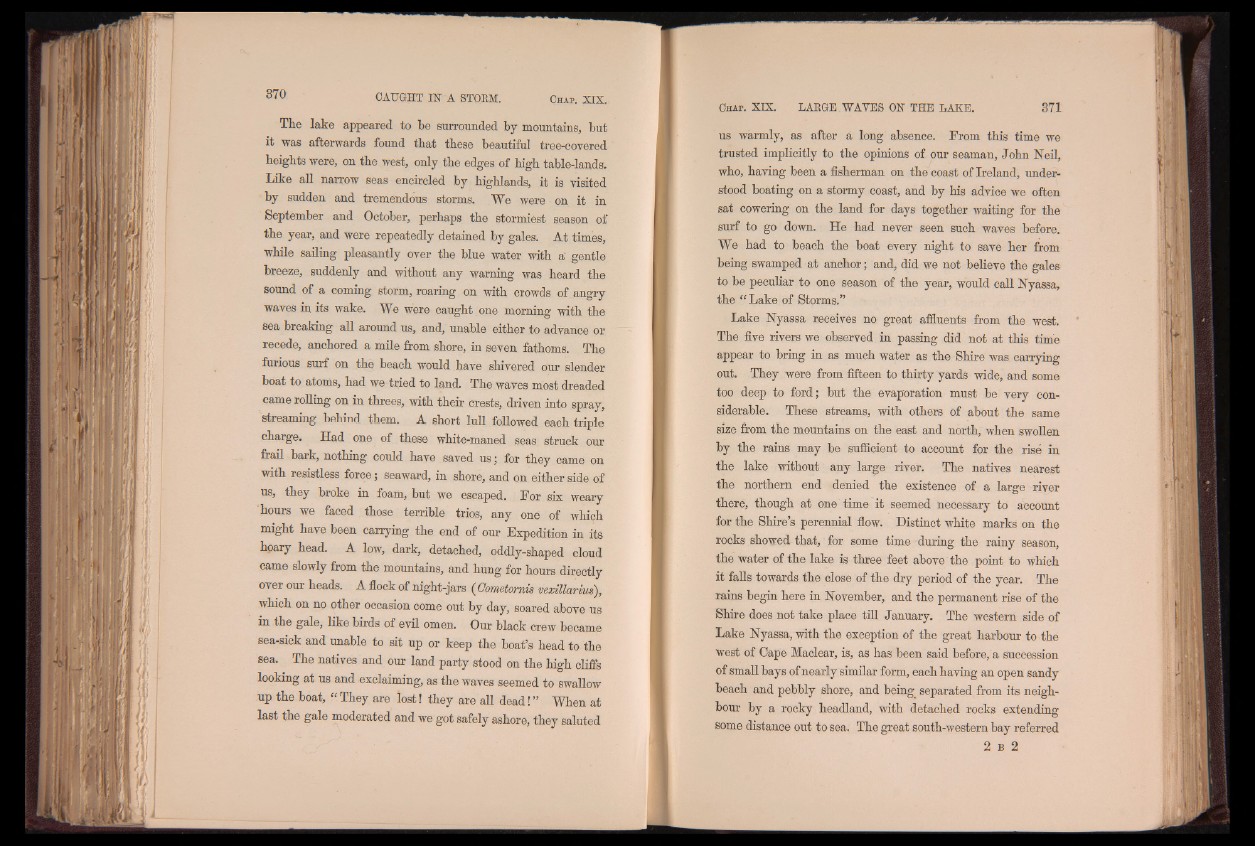
The lake appeared to be surrounded by mountains, but
it was afterwards found that these beautiful tree-covered
heights were, on the west, only the edges of high table-lands.
lik e all narrow seas encircled by highlands, it is visited
by sudden and tremendous storms. We were on it in
September and October, perhaps the stormiest season of
the year, and were repeatedly detained by gales. At times,
while sailing pleasantly over the blue water with a gentle
breeze, suddenly and without any warning was heard the
sound of a coming storm, roaring on with crowds of angry
waves in its wake. We were caught one morning with the
sea breaking all around us, and, unable either to advance or
recede, anchored a mile from shore, in seven fathoms. The
furious surf on the beach would have shivered our slender
boat to atoms, had we tried to land. The waves most dreaded
came rolling on in threes, with their crests, driven into spray,
streaming behind them. A short lull followed each triple
charge. Had one of these white-maned seas struck our
frail bark, nothing could have saved u s; for they came on
with resistless force; seaward, in shore, and on either side of
us, they broke in foam, but we escaped. For six weary
hours we faced those terrible trios, any one of which
might have been carrying the end of our Expedition in its
hoary head. A low, dark, detached, oddly-shaped cloud
came slowly from the mountains, and hung for hours directly
over our heads. A flock of night-jars ( Oometomis vexillarius),
which on no other occasion come out by day, soared above us
in the gale, like birds of evil omen. Our black crew became
sea-sick and unable to sit up or keep the boat’s head to the
sea. The natives and our land party stood on the high diffa
looking at us and exclaiming, as the waves seemed to swallow
up the boat, “ They are lost! they are all dead! 1 When at
last the gale moderated and we got safely ashore, they saluted
us warmly, as after a long absence. From this time we
trusted implicitly to the opinions of our seaman, John Neil,
who, having been a fisherman on the coast of Ireland, understood
boating on a stormy coast, and by his advice we often
sat cowering on the land for days together waiting for the
surf to go down. He had never seen such waves before.
We had to beach the boat every night to save her from
being swamped at anchor; and, did we not believe the gales
to be peculiar to one season of the year, would call Nyassa,
the “ Lake of Storms.”
Lake Nyassa receives no great affluents from the west.
The five rivers we observed in passing did not at this time
appear to bring in as much water as the Shire was carrying
out. They were from fifteen to thirty yards wide, and some
too deep to ford; but the evaporation must be very considerable.
These streams, with others of about the same
size from the mountains on the east and north, when swollen
by the rains may be sufficient to account for the rise in
the lake without any large river. The natives nearest
the northern end denied the existence of a large river
there, though at one time "it seemed necessary to account
for the Shire’s perennial flow. Distinct white marks on the
rocks showed that, for some time during the rainy season,
the water of the lake is three feet above the point to which
it falls towards the close of the dry period of the year. The
rains begin here in November, and the permanent rise of the
Shire does not take place till January. The western side of
Lake Nyassa, with the exception of the great harbour to the
west of Cape Maclear, is, as has been said before, a succession
of small bays of nearly similar form, each having an open sandy
beach and pebbly shore, and being< separated from its neighbour
by a rocky headland, with detached rocks extending
some distance out to sea. The great south-western bay referred
2 B 2